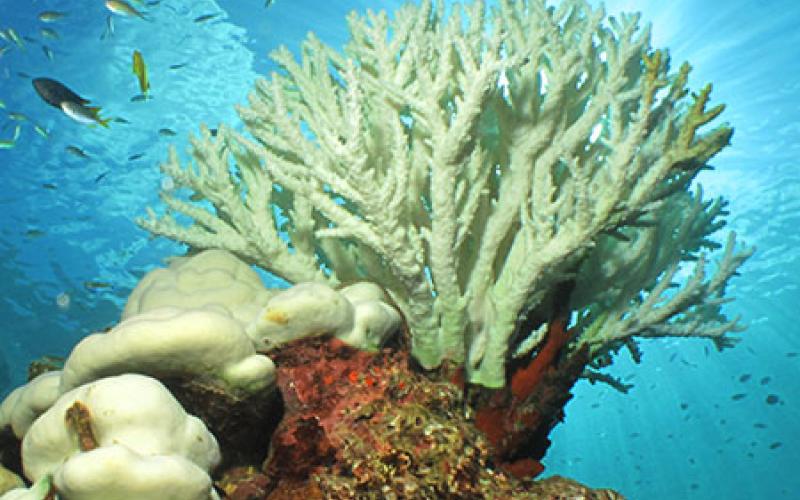Will corals survive humans?

Will corals survive humans?
We have entered an era where humans have had a profound impact on the planet. In this new world that we have created, what species will endure and what others shall perish? How can we predict what species they will be?
Norström, A. V., Nyström, M., Jouffray, J-B., Folke, C., Graham, NAJ., Moberg, F., Olsson, P., Williams, G.J. 2016. “Guiding coral reef futures in the Anthropocene.” Frontiers in Ecology and the Environment. 14(9): 490–498. DOI: 10.1002/fee.1427/epdf
Scientists say the planet has entered the Anthropocene, a new era in which humans are the primary driver of planetary change. As humans expand our sphere of influence, other ecosystems are becoming more vulnerable. A classic example are coral reefs, which have degraded significantly in the last 50 years.
A team of scientists led by Albert Norström of Stockholm University recently released its research on humankind’s impacts on coral reefs in The Ecological Society of America. Through literature review and past research, Norström and his colleagues identify the key causes to coral habitat destruction, why coral habitat is difficult to protect, new methods for setting protection guidelines, and why corals are important species to save.
The team suggests that corals are suffering mostly from three factors: overfishing, poor water quality, and global stressors like rising sea levels and ocean acidification. Overfishing removes key species that perform vital functions within an ecosystem. Water quality issues, such as sedimentation, can smother corals and interfere with their ability to reproduce. Rising sea temperatures kills coral tissue and causes coral bleaching. Ocean acidification makes it more difficult for corals to form their skeletons. These impacts are direct consequence of too much carbon dioxide in the atmosphere. By the time atmospheric carbon reaches 580 parts per million (today it is at 400 parts per million), corals may even start to dissolve back into the oceans.
In order to reduce global reef damage, Norström and his team state that we need to avoid the “tipping point” — or the point of no return — for coral destruction. We must keep an eye for the telltale signs of problems that negatively impact coral health, including the amount of carbon dioxide in the atmosphere, the amount of fish biomass, and how much chlorophyll is in the water. Crossing these breakpoints, they write, will trigger what is called a “regime shift,” or a change so massive that the ecosystem could not recover. Regime shifts mean extinction for corals and the ecosystems that they support. However, the nature of coral ecosystems makes it difficult to identify these tipping points.
A major challenge for establishing target water and air quality levels for coastal reef health is that is that it can take decades or even centuries to observe how human activity impacts these environments. This lag time makes it hard to know what kinds of things cause stress on ecosystems. Which, in turn, makes it challenging to predict tipping points for the collapse of coral reef ecosystems.
Researchers have consequently put forward an alternative approach to using tipping points. They suggest creating “safe operating spaces,” or identifying operations within a “safe” margin of error from these potentially irreversible breaking points. The researchers subsequently estimate safe operating spaces for the primary anthropogenic stresses — overfishing, water quality, water temperatures, and ocean acidification.
The authors point to the recent worldwide coral mass bleaching event — the second in history — as evidence for their claim that we have already passed into the “zone of uncertainty” for the safe operating space for sea temperature. This means we have passed into dangerous territory; we do not know at what point the corals will no longer be able to recover from the damage we have caused. We are quickly approaching these risk zones for the other two stress factors. By passing into these zones, we are moving into the unknown — it is unclear how far corals can be pushed before they disappear forever.
It is important to understand the relationship between humans and corals in order to prevent damage we cannot reverse, the authors emphasize. They suggest that trade, human migration, and land-grabbing for development have the largest impacts on the three primary ecosystem stressors. The global aquarium trade targets 1,800 species of reef fish and moves more than 30 million fish per year. Human migration is at unprecedented levels and changes all of the rules, invalidating traditional practices. Land-grabbing typically results in increased levels of pollution due to changes in how land is used. Understanding this relationship will help design management policies that address the true problems at hand.
This study highlights the need to shift to management strategies that are collaborative, flexible, and adaptive. The acts of individuals can make a significant difference, and the authors recommend that multi-level cooperation within governments is vital. Regional management initiatives will be the key to designing smart ways to keep coral reef environments within these “safe zones” before the Anthropocene leaves a permanent mark.




